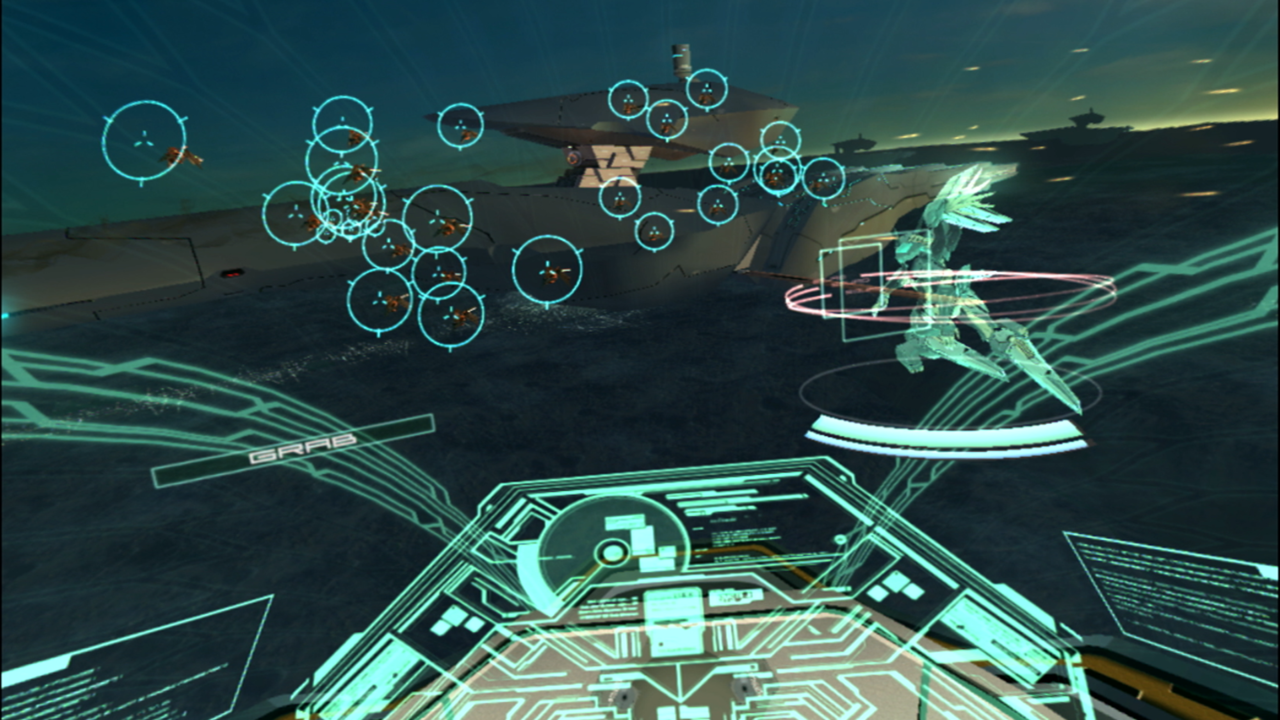Zone of the Enders got a bit of a bum rap as a series overall, being more famous as the game that came with the Metal Gear Solid 2 demo than anything else. Those with the patience, however, would discover one of the most distinct mech games of the day, with more than a heaping dollop of trademark Hideo Kojima madness therein. The 2nd Runner is an improvement on the original in many ways, to be certain, but held against modern standards, Zone of the Enders comes off awful rusty.
There is a story, but it's nigh incomprehensible, even with the caveat that Kojima's fingerprints are all over it. Having prior knowledge of the original doesn't help much either. Basically, two years after the events of the original Zone of the Enders, a miner named Dingo Egret on one of Jupiter's moons finds the frame-mech hero, Jehuty, buried beneath the surface. When the evil army BAHRAM nearly kills Dingo trying to retrieve the armor again, Jehuty is forced by a rebel spy to join with Dingo, keeping him alive using the mech's life support until they complete their mission of blasting the army straight to hell.

Ideally, you'd be able to simply barrel past the story and get to what's good, which is the mech combat, but The 2nd Runner's pacing stutters along. Every stride the game hits is interrupted to deliver more nonsensical ranting on unstoppable power, duty, and the nature of war. Soured even further by English voiceovers that are one step removed from Symphony of the Night-level broad theatrics, the story is a irritating rash all over what should be a fairly straightforward mech combat experience.
Simplicity, really, works in the game's favor. You have a sword, a laser, a rocket-assisted boost, and a shield. Each stage progresses on a fairly linear path, with tiny corridors and loading areas opening up into massive arenas where, for the most part, you're expected to kill everything that moves. Your enemies are generally either flying grunts around Jehuty's own size that go down easy, or swarms of tiny annoyances you can take down en masse by using a special missile barrage. That's generally the gameplay loop, and it only gets more exhilarating the more cannon fodder the game throws at you.
ZOE shows its age most is in its control scheme. It's not necessarily unworkable, but it involves unlearning 15 years of developers figuring out elegant ways of moving around 3D spaces. Two face buttons control elevation, while the dash button is unintuitively set to the shoulders. Despite much of Jehuty's moveset relying on dashing, and fast counter-maneuvers to get in and out of an opponent's space, the motions required to do so feel awkward, even in the new “Pro” configuration that remaps the shoulder buttons and subweapon selects.
The 4K bump in resolution and soundscape enhancements are certainly noticeable, but aside from introducing brand-new textures to the mix, ZOE was always going to wear its PS2 roots rather boldly. Honestly, the game would lose something without that trademark Kojima Productions cinematic judder during intense moments. Instead, Konami went the next step, allowing the entire game to be played in VR. It's a great idea, one that'd be a welcome experiment for a lot of older titles--there's certainly an extra level of immersion, and the aforementioned new soundscape really comes to life in VR, forcing you to use your ears more than your eyes to figure out where enemies and projectiles are coming from.
ZOE shows its age most is in its control scheme.
The control scheme still mucks things up quite a bit, however, and not being able to see your special moves as you use them is a pretty big detriment in busy stages. The game does try to mitigate this, keeping a holographic representation of your avatar as it would be in the regular game on the right-hand side of the cockpit, but taking your eyes off the action is a bad idea, especially during the game's frantic boss fights. Unfortunately, sometimes you have to; bosses have a bad habit of getting up close and personal. In a crowded area, the only thing stopping you from being cornered and slashed to death in three hits is the kind of situational awareness the VR mode doesn't inherently give you. There is a special VR difficulty mode that makes dealing with enemies easier, but it swings the game too far in the other direction towards cakewalk territory.
While Zone of the Enders: The 2nd Runner pushed the envelope when it first launched, it's more admirable for the ways in which it tries to inject depth into a formula that never required it to be successful. There are certainly ambitions to be appreciated, and Konami has at least put some effort into preserving the experience as it was, for better or worse. Still, those ambitions aren’t enough to fight the feeling that it hasn’t been outclassed several times over in the years since.













